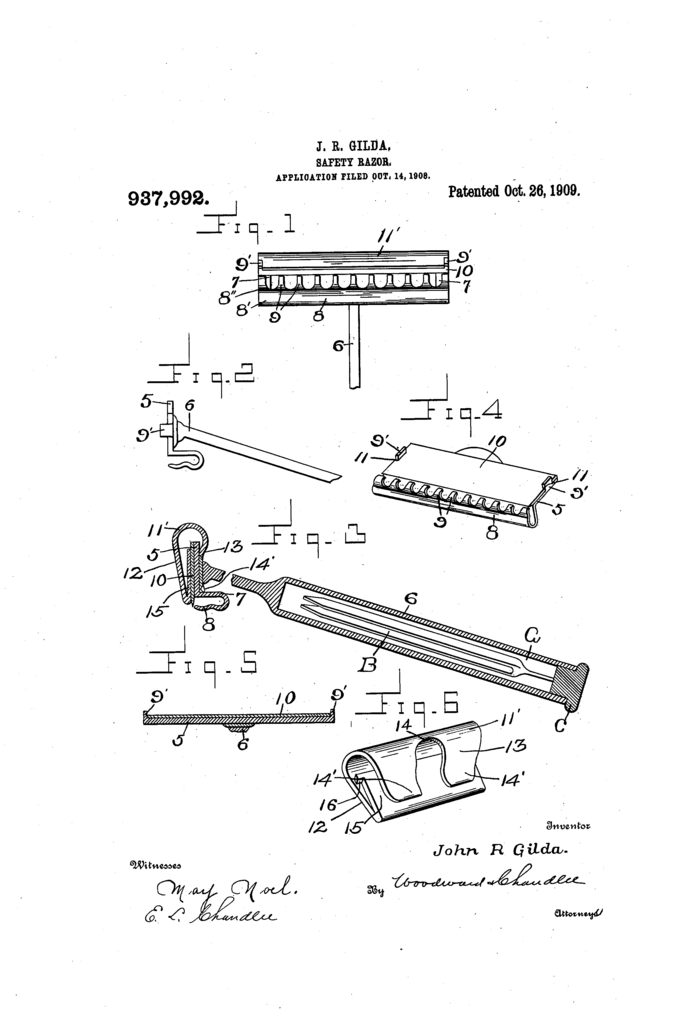Continuing on the theme of razors with stuff in the handle, we have an early patent for a razor with a pair of tweezers. And those may be the least interesting detail on this safety razor. Filed in 1908 and granted the year after, John R Gilda came up with a simple, single edged safety razor. While no blade is shown separate on the drawings, it probably would take blades similar to the Christy razors. After all, a lot of razors did in the early part of last century.
The Christy blade was, after all, easy to make a razor for. Looking much like a de-spined GEM-blade, there was no complex geometries to take into account. Positioning of the blade was done of the edge itself in most razors, meaning that the dimensions of the blade was less critical. The variation described for the Gilda razor had a pair of cutouts on either side, much like a modern GEM blade do.
The razor was also quite simple and straight forward. To quote the patent text:
…the present razor comprises a supporting plate 5 having a handle 6 secured thereto and extending downwardly from its center. Downwardly extending arms 7 are formed integral with the forward edge portion of the plate 5, the lower extremities of these arms being curved forwardly, and formed integral with these arms there is a comb 8 having upwardly directed fingers 9 terminating flush with the upper face of the plate 5; the comb includes a face portion 8 below the fingers, which is provided with a longitudinal rib 8′, to strengthen the structure as will be understood. At each end of the plate 5 there is an upwardly extending ear 9 which is formed integral with the plate, these ears being in alignment longitudinally of the plate.
From the patent text of US patent 937,992
A blade 10 is disposed upon the plate 5, and has notches 11 in its ends which receive the ears 9′, these ears thus holding the blade against both longitudinal and lateral movement. As shown, the fingers 9 lie in close relation to the cutting edge of the blade so that the cutting of the face of the user is prevented.
A spring clip 11 is provided to hold the blade upon the plate, this spring clip being formed of a single piece of spring metal, as shown, and including an upper lip 12 and a lower lip 13. The lower lip has a central cut away portion 14 and resultant space portion 14 which extend at opposite sides of the handle 6. The lower lip 13 has upwardly curved portions which engage the under face of the plate 5 as shown.
John R Gilda – or his lawyer – sure liked to use many words. In more modern and less verbose language:
The bottom plate is secured to the handle. The bottom plate also forms the guard, and have an ear on either side.
The blade has a pair of notches on each end, which rides on the ears. Thus the blade is secure from moving sideways as well as back and forth.
The blade is held in place by a spring clip, which also forms the top cap of the razor. The clip clips over both the blade and the bottom plate.
Overall a straightforward razor, that might have deserved to do better in the market place than it did. Robert K Waits link this patent to a razor known as the Cadwell’s Home Barber.1 To my eyes, however, the photo he provides don’t look too similar to the patent.

Oh, and the pair of tweezers? As can be seen, they are in the handle. To quote the relevant part of the patent:
The handle 6 is provided with a chamber A opening through its rear end for the reception of a pair of tweezers B, the chamber being provided with a cap C.
From the patent text of US patent 937,992
That is all. No mention in the claims, nothing. Just a single sentence.
The patent is long expired, of course. There should be little trouble adjusting the design for a modern GEM-blade. So, if someone feels like making the safety razor of John R Gilda a modern reality, just go ahead. With, or perhaps without, the pair of tweezers.
The full patent can be read, as usual, on Google Patents.
Footnotes:
- Refer to page 40 in Waits’ Compendium.
